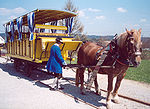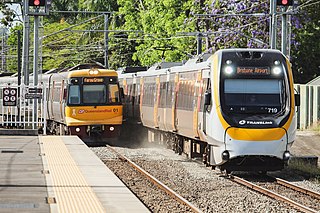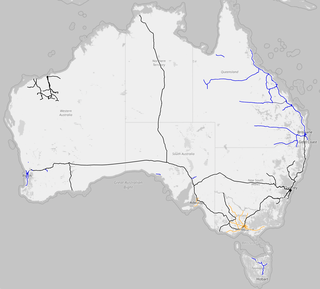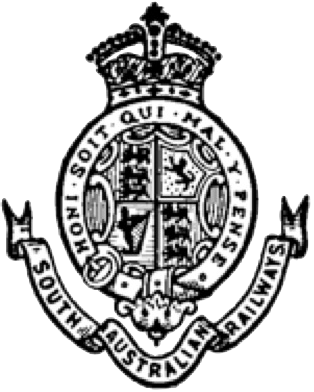
This is a worldwide list of horse-drawn railways, an early form of rail transport that utilised horses and other similar animals to pull rail cars. Horses were also used for shunting.

This is a worldwide list of horse-drawn railways, an early form of rail transport that utilised horses and other similar animals to pull rail cars. Horses were also used for shunting.
Horses were used to pull railways in funiculars and coal mines as early as early 16th century. The earliest recorded example is the Reisszug, a. inclined railway dating to 1515. Almost all of the mines built in 16th and 17th century used horse-drawn railways as their only mode of transport[ citation needed ].
| Name | Years of operation | Gauge | Location | Image | Notes |
|---|---|---|---|---|---|
| Ticknall Tramway | 1802–1913 | 4 ft 2 in (1,270 mm) | Ticknall, England |  | |
| Swansea & Mumbles Railway | 1804–1877 | 1,435 mm (4 ft 8+1⁄2 in) | Swansea, Wales |  | The world's first passenger railway service. Later electrified [1] [2] |
| Leiper Railroad | 1810–1828 | 4 ft (1,219 mm) | Delaware County, Pennsylvania | The first permanent tramway in America | |
| Bryn Oer Tramway | 1814–1861 | 3 ft 6 in (1,067 mm) | Talybont-on-Usk, Wales |  | |
| Hill's Tramroad | c. 1815 – c. 1926 | 2 ft (610 mm) | Llanfoist, Wales |  | |
| Hay Railway | 1816–1860 | 1,067 mm (3 ft 6 in)/ 1,435 mm (4 ft 8+1⁄2 in) | Eardisley, England to Brecon, Wales |  | Converted from 1,067 mm (3 ft 6 in) gauge plateway to 1,435 mm (4 ft 8+1⁄2 in) gauge edgeway |
| Blaafarveværket | Opened c. 1820s | Norway | |||
| Plymouth and Dartmoor Railway | 1823–1888, 1860) [ clarification needed ] | 4 ft 6 in (1,372 mm) | Princetown, England |  | |
| Stockton and Darlington Railway | 1825–1833 | 1,435 mm (4 ft 8+1⁄2 in) | Darlington, England |  | Operated with both horses and engines between 1825 and 1833 |
| Granite Railroad | 1826–1871 | 1,524 mm (5 ft) | Quincy, Massachusetts |  | |
| Saint-Étienne–Andrézieux railway | 1827– | 1,435 mm (4 ft 8+1⁄2 in) | France |  | |
| České Budějovice–Linz Railway | 1828– | 1,106 mm (3 ft 7+1⁄2 in) |  | The first public railway in continental Europe | |
| Bavarian Ludwig Railway | 1835–1863 | 1,435 mm (4 ft 8+1⁄2 in) | Fürth, Germany | ||
| Whitby and Pickering Railway | Opened 1836 | 1,435 mm (4 ft 8+1⁄2 in) | Whitby, England |  | |
| Port Arthur, Tasmania Tramway | 1836– | Human powered | |||
| Festiniog Railway | 1836–1863 [3] | 1 ft 11+1⁄2 in (597 mm) | Porthmadog, Wales |  | Horses hauled empty trains uphill, and rode down in Dandy waggons under gravity power. Later replaced by steam locomotives. |
| Patent (1838–1844) G. Peppercorne [4] | [ What railway is this? ] | ||||
| Bratislava to Svätý Jur to Trnava Váh horse railway | 1840 – 10 October 1872 | 1,435 mm (4 ft 8+1⁄2 in) [5] [6] | |||
| Bazias to Anina via Oravița | 1846–1863 | Present-day Romania | Used for coal transport to a port on the river Danube | ||
| Leith and Musselburgh Tramway | 1841– [7] |
| Name | Years of operation | Gauge | Location | Image | Notes |
|---|---|---|---|---|---|
| Fintona Railway | 1853–1957 | 1,600 mm (5 ft 3 in) [8] | Ireland |  | |
| Goolwa Port Elliot Railway | 1854–1884 | 1,600 mm (5 ft 3 in) | Extended to Victor Harbor and Strathalbyn by 1869. Used up to 16 horses, [9] 29 to Strathalbyn [10] | ||
| Treffry Tramways | 1835– | Clay mining | |||
| 1861-? [11] | Nelson, New Zealand | ||||
| Dun Mountain Railway | 1861–1901 | 914 mm (3 ft) |  | ||
| Wallaroo (smelter and port) to Moonta (mines) – tramway | 1862–1890s [12] [13] | South Australia | |||
| Port Macdonnell to Mount Gambier – proposal | South Australia | Proposed, but never built [14] | |||
| Omaha Horse Railway | 1867–1889 | Omaha, Nebraska | |||
| Port Wakefield Railway | 1870–1876 | 1,067 mm (3 ft 6 in) | South Australia | Converted to locomotive haulage | |
| Kingston-Naracoorte railway line | 1871 | 1,067 mm (3 ft 6 in) | South Australia | Operated with horses for first six months after construction before locomotives were available | |
| Ferrocarril de Antofagasta a Bolivia | 1873–1876 | 762 mm (2 ft 6 in) | Chile | Mule-drawn | |
| Douglas Bay Horse Tramway | 1876–present | 3 ft (914 mm) | Douglas, Isle of Man | Shires and Clydesdales are used to pull a fleet of original tramcars along the seafront. | |
| Port Broughton | 1876–1926 | 1,067 mm (3 ft 6 in) | South Australia |  | Always isolated; locomotives proposed in 1906 [15] |
| Namaqualand Railway | opened 1869–1876 | 762 mm (2 ft 6 in) | Steam followed gradually | ||
| Kailan – Lutai Canal | 1878–1881 | Mule-drawn for coal [16] |
| Name | Years of operation | Gauge | Location | Image | Notes |
|---|---|---|---|---|---|
| Horse Tramways in Fiji | 1884– | 762 mm (2 ft 6 in) 610 mm (2 ft) | Fiji | Some assisted by manpower. Cane tramways. | |
| Spiekeroog tramways | 1885-1949 | 4 ft 8+1⁄2 in (1,435 mm) | East Frisian Islands, Germany | The last horse-drawn railway in Germany. Horses were replaced by diesel locomotives on 31 May 1949 | |
| McKenzie Creek Tramway | 1887–1925 | Horsham, Victoria | Shire-operated, 8 kilometres (5 mi) long | ||
| Nasik Tramway | 1889–1930s | India | |||
| Bärschwil gypsum railway | 1894–1952 | 2 ft (610 mm) | Switzerland | ||
| Welshpool Jetty railway | 1905–1941 | 2 ft 6 in (762 mm) | Port Welshpool, Victoria, Australia |  | |
| Finton Tramway | Closed 1957 | 1,600 mm (5 ft 3 in) [17] | Ireland | ||
| Gawler [18] | 1879–1931 | 5 ft 3 in (1,600 mm) | Gawler, South Australia |  | |
| Moonta [18] | Yorke Peninsula, South Australia |

Princes Highway is a major road in Australia, extending from Sydney via Melbourne to Adelaide through the states of New South Wales, Victoria and South Australia. It has a length of 1,941 kilometres (1,206 mi) or 1,898 kilometres (1,179 mi) via the former alignments of the highway, although these routes are slower and connections to the bypassed sections of the original route are poor in many cases.

Sturt Highway is an Australian national highway in New South Wales, Victoria, and South Australia. It is an important road link for the transport of passengers and freight between Sydney and Adelaide and the regions along the route.

The Powerhouse Museum is the major branch of the Museum of Applied Arts & Sciences (MAAS) in Sydney, and owned by the Government of New South Wales. The Powerhouse is a collection of museums with its main centre in Ultimo, New South Wales, the others being the historic Sydney Observatory at Observatory Hill, and the newer Museums Discovery Centre at Castle Hill.

Gundagai is a town in New South Wales, Australia. Although a small town, Gundagai is a popular topic for writers and has become a representative icon of a typical Australian country town. Located along the Murrumbidgee River and Muniong, Honeysuckle, Kimo, Mooney Mooney, Murrumbidgee and Tumut mountain ranges, Gundagai is 390 kilometres (240 mi) south-west of Sydney. Until 2016, Gundagai was the administrative centre of Gundagai Shire local government area. In the 2021 census, the population of Gundagai was 2,057.

Rail transport in Australia is a component of the Australian transport system. It is to a large extent state-based, as each state largely has its own operations, with the interstate network being developed ever since Australia's federation in 1901. As of 2022, the Australian rail network consists of a total of 32,929 kilometres (20,461 mi) of track built to three major track gauges: 18,007 kilometres (11,189 mi) of standard gauge, 2,685 kilometres (1,668 mi) of broad gauge, and 11,914 kilometres (7,403 mi) of narrow gauge lines. Additionally, about 1,400 kilometres (870 mi) of 610 mm / 2 ft gauge lines support the sugar-cane industry. 3,488 kilometres (2,167 mi), around 11 per cent of the Australian heavy railways network route-kilometres are electrified.

The former Central Australia Railway, which was built between 1878 and 1929 and closed in 1980, was a 1241 km (771 mi) 1067 mm narrow gauge railway between Port Augusta and Alice Springs. A standard gauge line duplicated the southern section from Port Augusta to Maree in 1957 on a new nearby alignment. The entire Central Australia Railway was superseded in 1980 after the standard gauge Tarcoola–Alice Springs Railway was opened, using a new route up to 200 km to the west. A small southern section of the original line between Port Augusta and Quorn has been preserved as the Pichi Richi Tourist Railway.

Francis William Cadell was a European explorer of Australia, most remembered for opening the Murray River up for transport by steamship and for his activities as a slave trader.

The first railway in colonial South Australia was a line from the port of Goolwa on the River Murray to an ocean harbour at Port Elliot, which first operated in December 1853, before its completion in May 1854.

Port Adelaide is a port-side region of Adelaide, approximately 14 kilometres (8.7 mi) northwest of the Adelaide CBD. It is also the namesake of the City of Port Adelaide Enfield council, a suburb, a federal and state electoral division and is the main port for the city of Adelaide. Port Adelaide played an important role in the formative decades of Adelaide and South Australia, with the port being early Adelaide's main supply and information link to the rest of the world. Its Kaurna name, although not officially adopted as a dual name, is Yartapuulti.

The Australian Rail Track Corporation (ARTC) is an Australian Government-owned statutory corporation.

The Trans-Australian Railway, opened in 1917, runs from Port Augusta in South Australia to Kalgoorlie in Western Australia, crossing the Nullarbor Plain in the process. As the only rail freight corridor between Western Australia and the eastern states, the line is economically and strategically important. The railway includes the world's longest section of completely straight track.

Rail gauges in Australia display significant variations, which has presented an extremely difficult problem for rail transport on the Australian continent since the 19th century. As of 2022, there are 11,914 kilometres (7,403 mi) of narrow-gauge railways, 18,007 kilometres (11,189 mi) of standard gauge railways and 2,685 kilometres (1,668 mi) of broad gauge railways. In the 19th century, each of the colonies of Australia adopted their own gauges.

South Australian Railways (SAR) was the statutory corporation through which the Government of South Australia built and operated railways in South Australia from 1854 until March 1978, when its non-urban railways were incorporated into Australian National, and its Adelaide urban lines were transferred to the State Transport Authority.

The earliest trams in Australia operated in the latter decades of the 19th century, hauled by horses or "steam tram motors". At the turn of the 20th century, propulsion almost universally turned to electrification, although cable trams lingered in Melbourne. In cities and towns that had trams, they were a major part of public transport assets.

The Lady Outlaw is a 1911 Australian silent film set in Van Diemen's Land during convict days.
This is a list of captains and boat owners and others important in the history of the Murray-Darling steamer trade, predominantly between 1850 and 1950.

The Morgan railway line or North-West Bend railway was a railway line on the South Australian Railways network.
The Australian Transport Officers' Federation (ATOF) was an Australian trade union representing salaried officers in the transport sector, particularly in the rail and airline industries. It existed from 1924 until 1991, and was previously known as the Federation of Salaried Officers of Railways Commissioners (1924–1947) and the Australasian Transport Officers Federation (1947–1978). The union had a policy of supporting conciliation and arbitration and against strike action until 1970.